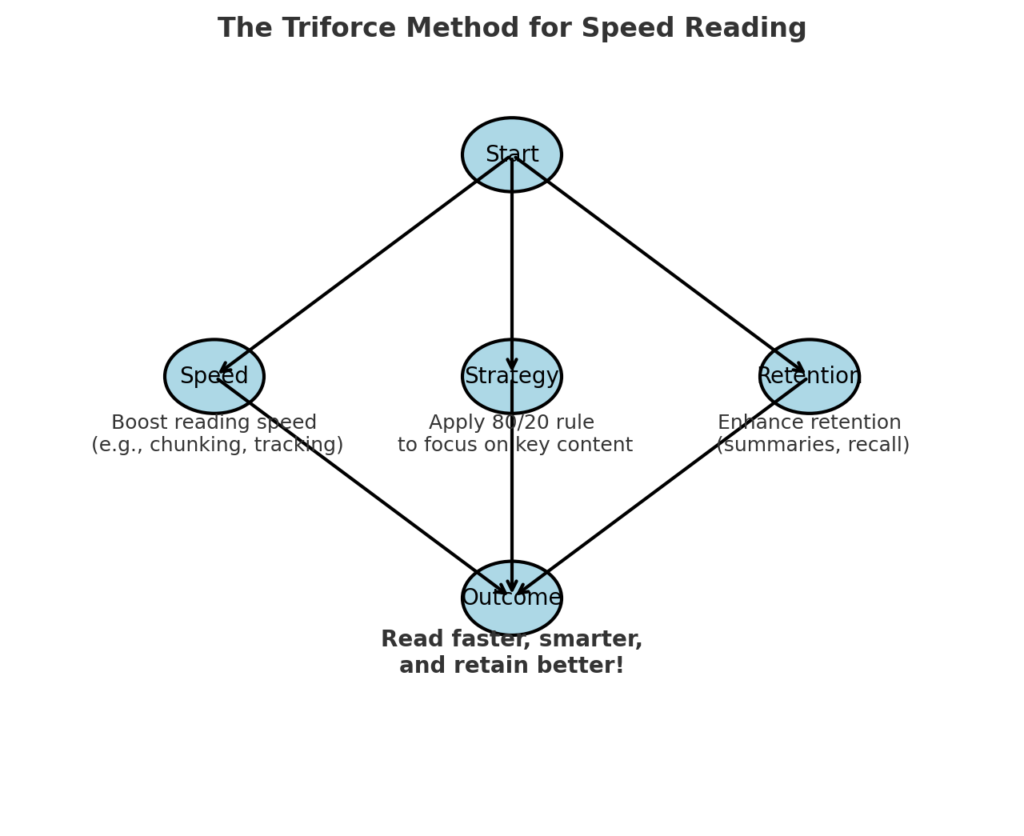Reading is a superpower, and mastering it at lightning speed can be life-changing. Picture yourself finishing books in days that others spend months on, all while casually sipping your coffee like a bookish wizard. Whether for personal growth, school, or career, learning to read faster while retaining what you learn is a skill worth having. This isn’t just about speed—it’s about 3x fast learning, where you absorb and retain information efficiently. Let’s break down how you can triple your reading speed in just one week with practical steps.
Day 1: Understanding the Science of Speed Reading
Before diving into speed-reading hacks, let’s tackle a truth bomb: Reading isn’t just about speed; it’s about comprehension. It’s like rushing to the airport but forgetting your luggage—what’s the point?
Key Concepts:
- Baseline Reading Speed: Measure your current reading speed using tools like Speer. The average adult reads at 200-300 words per minute (WPM), so don’t sweat it if that’s where you’re starting. Knowing your baseline is half the battle.
- Internal Monologue (Subvocalization): Ever catch yourself narrating words in your head while reading? That’s your internal monologue slowing you down. The goal is to silence that voice and let your eyes do the heavy lifting. Fun fact: Your brain processes visual information way faster than auditory input—no offense to your inner narrator.
Action Steps:
- Practice seeing words as visual symbols rather than “hearing” them. Think of it as decoding secret messages.
- Use apps like Spritz or Spreeder to train your brain for 3x fast learning by reducing subvocalization..
- Start with simple tasks, like skimming headlines, and gradually apply this technique to more complex texts.
Day 2: Mastering the Triforce Method — Step 1: Speed
Meet the “Triforce Method”—your new best friend for reading faster. Think of it as the Avengers of reading techniques, combining speed, strategy, and retention. Today, let’s focus on the speed element.
Techniques to Boost Speed:
- Visual Tracking: Use a pen, finger, or stylus to guide your eyes across the text. It’s like having a laser pointer for your reading—no detours or backtracking.
- Example Exercise:
- Move your tracker across a line of text at a steady pace.
- Gradually increase the speed over time. You’ll go from a casual stroll to reading at warp speed. Research shows this technique minimizes unnecessary regressions, saving precious milliseconds.
- Example Exercise:
- Chunking: Stop reading word by word (a.k.a. snail mode) and start absorbing groups of words or phrases. It’s like upgrading from a flip phone to a smartphone. For example, instead of reading “The… cat… sat… on… the… mat,” train your eyes to see it as one visual chunk.
- Daily Drills: Dedicate 15-20 minutes to speed drills using apps like Beeline Reader or Spreeder. Think of it as cardio for your brain—except you don’t need sneakers.
Day 3: Triforce Method — Step 2: Strategy
Speed without strategy is like running in circles—you’re moving fast but not getting anywhere. Enter the 80/20 Rule of Reading:
What Is the 80/20 Rule?
The 80/20 Rule says 80% of a book’s value comes from 20% of its content. The trick? Finding those golden nuggets and skipping the filler. Think of it as mining for gold in a sea of words.
How to Apply It:
- Skim and Scan:
- Skim chapter summaries, headings, and subheadings to locate the juicy parts.
- Scan for keywords or themes—like speed-dating for books. In a self-help book, for instance, focus on actionable tips rather than lengthy anecdotes.
- Dynamic Reading:
- Slow down for critical sections where comprehension matters most.
- Speed through fluff, examples, or flowery descriptions of sunsets. Not every word deserves your full attention—some are just background noise.
- Pre-Read and Preview:
- Read the introduction, table of contents, and conclusion first to grasp the main ideas. It’s like watching a trailer before committing to the movie.
If you’re reading digitally, use Ctrl+F to locate specific terms. It’s a cheat code for efficiency.

Day 4: Triforce Method — Step 3: Retention
Reading without retention is like filling a bucket with holes. Let’s patch those leaks with strategies for remembering and applying what you’ve read.
Steps to Improve Retention:
- Summarization: After each page or section, write a 1-2 sentence summary. It keeps your brain engaged and helps you identify gaps in understanding. If you just read about habit formation, your summary might be, “Small, consistent actions lead to big changes.”
- Teach What You Learn: Try explaining a concept to someone else—even your dog. If they look confused, refine your explanation. Bonus: Talking to your dog makes you look quirky, not crazy.
- Take Notes Effectively: Use techniques like Mind Mapping or the Cornell Method for non-linear note-taking. Highlighting everything is just glorified procrastination—focus on key takeaways instead.
- Active Recall and Spaced Repetition:
- Regularly review your notes.
- Use apps like Anki to reinforce what you’ve learned. It’s like a workout for your memory, and neuroscience loves it.
Real-Life Application:
For non-fiction books like Atomic Habits, don’t just read—act. Create a habit tracker or apply one of the book’s principles for a week. The best way to remember is to do.
Day 5: Optimizing Reading for Different Genres
Not all books are created equal. Fiction, non-fiction, and academic texts require different approaches—it’s like switching gears for different terrains.
Fiction:
- Visualize scenes and connect with characters. Basically, turn the story into a Netflix binge in your head.
- Avoid overusing speed-reading techniques in dialogue-heavy sections—you don’t want to miss the juicy drama.
Non-Fiction:
- Focus on actionable insights over fluff.
- Use the SQ3R Method (Survey, Question, Read, Recite, Review) to break down complex ideas.
Academic Texts:
- Start with abstracts, introductions, and conclusions for an overview.
- Highlight formulas, diagrams, and key terms—these are the VIPs of dense material.
Day 6: Tools and Technology to Enhance Reading
Why do it the hard way when tech can help? Here’s how to use gadgets to supercharge your reading.
Digital Tools:
- Speed Reading Apps:
- Spreeder: Boosts visual processing.
- Spritz: Displays one word at a time, cutting out eye movement.
- Note-Taking Apps:
- Evernote or Notion: Perfect for organizing summaries and ideas.
- Audiobooks and Hybrid Reading:
- Combine reading and listening with apps like Audible or Kindle’s Whispersync.
Physical Aids:
- Use blue-light-blocking glasses to protect your eyes during marathon reading sessions.
- Invest in ergonomic seating—because no book is worth back pain.
Day 7: Consolidating and Reflecting
You’ve made it! Now it’s time to turn these new habit with 3x fast learning into a lifelong skill.
Reflect and Review:
- Daily Reflection: Spend a few minutes reviewing your progress. What worked? What didn’t? Be honest.
- Set Goals:
- Short-term: Finish one book in a day.
- Long-term: Set monthly or yearly reading targets. Dream big.
- Build a Reading Ritual: Create a cozy, distraction-free space and schedule regular reading times. Consistency is key—Rome wasn’t built in a day, and neither is a reading habit.
Bonus Tips to Maintain Momentum
- Read Purposefully: Always ask yourself, “Why am I reading this?” Having a clear goal keeps you motivated.
- Mix It Up: Alternate between light and heavy reading material to keep things fresh.
- Join Communities: Participate in book clubs or online forums to share insights and stay accountable.
The Result: Transforming Your Reading Experience
By following this 7-day plan, you’ll not only read 3x faster but also smarter. These techniques are about making the most of your time and truly absorbing what you read. So grab a book, put these strategies to work, and do 3x fast learning. Happy reading—and don’t forget to brag a little!
FAQs
What is a good reading speed?
A typical adult reads at 200-300 WPM. With speed-reading techniques, you can increase this to 500+ WPM.
Can speed reading lower comprehension?
Initially, it might if you push too hard. The goal is balance: Increase speed gradually while ensuring comprehension remains high.
What are the best apps for speed reading?
Apps like Spreeder, Spritz, and Beeline Reader are excellent for training and practice.
How can I retain more of what I read?
Use summarization, active recall, and spaced repetition techniques. Teaching others what you’ve learned is also highly effective.
How soon can I expect results?
With consistent practice, many see noticeable improvements in speed and retention within a week.
Image source: pexels







